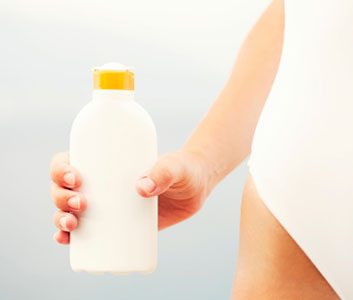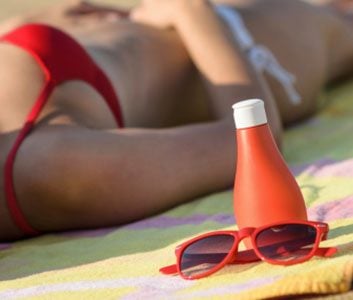
Concern: “Why does the message on the bag from my yoga clothing store say that sunscreen absorbed into skin might be worse than sunshine?”
Some of Lululemon’s tote bags are emblazoned with that message, followed by “Get the right amount of sunshine.” The statement lacks details, but we looked into the science. Three chemicals (and possibly others) commonly used as UV filters in sunscreens have been shown to cause ROS (reactive oxygen species) to generate. Kerry Hanson, a senior research chemist at University of California, Riverside, who researches sunscreen and ROS, explains that we produce ROS in our bodies both naturally and upon exposure to UV light, to help signal important biochemical processes. “The bad side of ROS is that they also react with cellular components like cell membranes or collagen and possibly with DNA. Over a lifetime, this could potentially increase the oxidative load on the skin, and lead to skin damage.”
The UV filters in sunscreen studied by Hanson and shown to cause ROS to generate were oxybenzone and octylmeth-oxycinnamate (primarily used to block UVB rays, which penetrate the outer layer of skin and are responsible for most skin cancers and cataracts), and octocrylene (used to stabilize avobenzone, one of the only UV filters approved by governments to filter UVA). UVA rays have longer wavelengths and are more prevalent than UVB; UVA also plays a role in certain skin cancers. (This is why you should choose sunscreens labelled “broad spectrum” or “UVB/UVA”; otherwise, you are protected only from UVB rays.) But there is a huge caveat when it comes to ROS production: “Certain conditions must be met before the molecules in any chemical can generate it,” says Hanson. “Those conditions include the molecule penetrating the skin, and then UV light reaching that molecule.”
You can prevent ROS from being generated if you reapply sunscreen every two hours, says Hanson, citing the Skin Cancer Foundation guidelines. Consistent reapplication ensures that UV light will not reach the molecule because there is a constant coating of UV filters on the top layer of your skin, she says (important, since it is known that UV filters can penetrate into skin).
The goal of sunscreen formulators, Hanson adds, is to find a formula that “acts more like latex paint on a wall, and just sits on the surface of the skin.”
Bottom Line: So is absorption of sunscreen putting you in danger? The amount of chemical that penetrates the skin varies by individual because skin barrier properties are different from person to person. “It’s important to emphasize that the FDA deems UV filters to be safe [so does Health Canada], and when used correctly they prevent sunburns that can lead to potentially deadly skin cancer,” says Hanson.

Concern: “I heard that a chemical that filters UV rays causes hormone disruption.”
As mentioned, many sunscreens contain oxybenzone, also known as benzophenone-3. According to the U.S. Centers for Disease Control and Prevention, it has been detected in the blood of more than 96 percent of the population. The Environmental Working Group (EWG), a U.S. environmental advocacy organization, contends that this chemical may disrupt hormones. Research on humans has only started recently, but early results are showing a correlation between concentrations of benzophenone-3 in the body, and an increased risk of endometriosis in women and lower birth weight in female babies. Based on this, the EWG recommends choosing a sunscreen that is made with mineral filters such as zinc oxide and titanium dioxide (more on those later) rather than choosing oxybenzone.
That said, oxybenzone is approved by Health Canada and listed as acceptable in Health Canada’s Sunscreen Monograph, the approved guideline for companies that make sunscreens. Also, says Darren Praznik, president of the Canadian Cosmetic, Toiletry and Fragrance Association (the trade association for personal care products and cosmetics in Canada), oxybenzone has been confirmed as safe for use as a photo stabilizer to protect cosmetic formulations by the Cosmetic Ingredient Review Expert Panel (an independent panel of scientific and medical experts funded by the Personal Care Products Council, the U.S. trade association). Praznik adds: “The European Union’s Scientific Committee on Consumer Products also officially stated that benzophenone-3 in sunscreens and all cosmetics does not pose a health risk to the consumer.”
Bottom Line: Schwarcz says oxybenzone can mimic the behaviour of estrogens, at least in fish that have been exposed to high doses. “But-and it’s a big but-there is no evidence in the scientific literature of oxybenzone being linked to any human health problem, except for photodermatitis, a skin reaction in some people that is triggered by exposure to sunlight.” And, he points out, there are hundreds and hundreds of compounds-both natural and synthetic-that could be linked to problems if they were scrutinized in the same way as oxybenzone. Substances that have been definitively proven to be estrogenic in humans, he adds, include phthalates, bisphenol A and various pesticides. “We live in a world full of hormone-like substances, and a complete analysis of our blood would reveal hundreds of these. All of this goes to say that, in my opinion, the risks of oxybenzone as implied by the Environmental Working Group are overstated.”
For those still concerned, he recommends another effective broad-spectrum sunscreen chemical called tetraphalydine dicamphor sulphonic acid, which goes by the trade name Mexoryl and is exclusive to L’Oréal. “It is stable, absorbs UV light and dissipates the energy as harmless heat. Mexoryl isn’t absorbed through the skin and so far there are no safety issues.” Like the EWG, he also suggests using sunscreens containing titanium dioxide and zinc oxide.

Concern: “Is it true that sunscreens containing vitamin A may actually speed skin-cancer development?”
The anti-aging ingredient retinyl palmitate (RP), a form of vitamin A, is added to more than 20 percent of the beach and sport sunscreens, face sunscreens and SPF-rated makeup products in the EWG’s 2013 sunscreen database.Research has been conducted to determine whether it acts as a photo-carcinogen, meaning that when exposed to light, it speeds up development of skin tumours. One animal study has shown this is the case, according to the EWG. A study by the U.S. National Toxicology Program and the FDA’s National Center for Toxicological Research found that RP speeds up the development of tumours on UV-treated lab animals; however, researchers said more studies are needed.
The Cosmetic Ingredient Review Expert Panel has assessed the safety of RP three times and concluded that it is safe for use in cosmetics, says Praznik. “There is no compelling evidence that RP in sunscreen products presents any human health risk to consumers.” Health Canada currently permits the use of it and retinol (another form of vitamin A) in cosmetics and personal-care products at concentrations equal to or less than 1% retinol equivalents.
Bottom Line: Schwarcz says the animal study mentioned above was not published in peer-reviewed literature (meaning it may not be sound), and it did not compare sunscreens containing the ingredient. Instead, he points to a 2009 study by L’Oréal Research and Development, published in Mutation Research, that examined the combined effect of ultraviolet light and RP on hamster ovary cells, a protocol that is consistent with the current recommendations for effective testing of photo-genotoxicity. “This published, peer-reviewed study concluded that retinyl palmitate had no photo-genotoxic potential.”
We will keep you posted as further research comes out. Meantime, if you are still concerned about the additive, use a sunscreen without it. Wear a hat and avoid the sun during peak hours; sun protection is the best way to prevent wrinkles anyway.

Concern: “I read that nanominerals in sunscreen, namely zinc oxide and titanium dioxide, are dangerous.”
Sunscreen formulators have long been using these two mineral-derived ingredients, which are considered “physical” sunscreens, to block both UVB and UVA rays. But many consumers don’t like that they leave a white residue on the skin.
So nano-sized (super-microscopic or “micronized”) molecules were created; sun protection products using this technology started coming on the market in the early 1980s. Because of the newness of nanotechnology (in the scientific world, 30 years is new), there is not a lot of knowledge about what impact the products may have on our bodies; people assume they would absorb more easily into the skin than would “regular-sized” molecules, and that seems only logical.
But Health Canada and the European Commission’s Scientific Committee on Consumer Safety have recently completed reviews of nano-scale zinc oxide and titanium dioxide, and have neither identified any risk, nor issued any warnings to consumers. Additionally, the Therapeutic Goods Administration in Australia, a regulatory agency for medical drugs and devices (and a global leader in sunscreen research due to that country having the highest incidence of skin cancer in the world), states that “the current weight of evidence suggests that titanium dioxide and zinc oxide nanoparticles (commonly used active ingredients in sunscreens) do not reach viable skin cells; rather, they remain on the surface of the skin and in the outer layer of the skin
that is composed of non-viable cells.” The Canadian Dermatology Association has officially stated, “There is no evidence to suggest that the application of sunscreen products containing micronized zinc oxide and titanium dioxide will result in toxicity. If applied on healthy skin, there is no evidence that these products penetrate beyond the outer layers of the stratum corneum [top layer of skin].”
Bottom Line: There is no reason to fear that using sunscreens containing nano-sized zinc oxide and titanium dioxide is dangerous. If research contradicting that comes to light, we will keep you informed.
